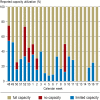Extracorporeal lung support in H1N1 provoked acute respiratory failure: the experience of the German ARDS Network
- PMID: 24069078
- PMCID: PMC3782024
- DOI: 10.3238/arztebl.2013.0543
Extracorporeal lung support in H1N1 provoked acute respiratory failure: the experience of the German ARDS Network
Abstract
Background: During the H1N1 pandemic of 2009 and 2010, the large number of patients with severe respiratory failure due to H1N1 infection strained the capacities of treatment facilities for extracorporeal membrane oxygenation (ECMO) around the world. No data on this topic have yet been published for Germany.
Methods: During the pandemic, the German ARDS Network (a task force of the DIVI's respiratory failure section) kept track of the availability of ECMO treatment facilities with a day-to-day, Internet-based capacity assessment. In cooperation with the Robert Koch Institute, epidemiological and clinical data were obtained on all patients treated for influenza in intensive care units.
Results: 116 patients were identified who had H1N1 disease and were treated in the intensive care units of 9 university hospitals and 3 other maximum medical care hospitals. 61 of them received ECMO. The overall mortality was 38% (44 of 116 patients); among patients receiving ECMO, the mortality was 54% (33 of 61 patients). The mortality was higher among patients who had an accompanying malignancy or immune deficiency (72.2%).
Conclusion: Even persons without any other accompanying disease developed life-threatening respiratory failure as a result of H1N1 infection, and many of these patients needed ECMO. This study reveals for the first time that the mortality of H1N1 infection in Germany is comparable to that in other countries. H1N1 patients with acute respiratory failure had a worse outcome if they also had serious accompanying diseases.
Figures



References
-
- RKI, Arbeitsgemeinschaft Influenza. Bericht zur Epidemiologie der Influenza in Deutschland, Saison 2009/10. Accessible at: www.influenza.rki.de.
-
- Thompson WW, Shay DK, Weintraub E, et al. Mortality associated with influenza and respiratory syncytial virus in the United States. JAMA. 2003;289:179–186. - PubMed
-
- Jain S, Benoit SR, Skarbinski J, et al. Influenza-Associated Pneumonia Among Hospitalized Patients With 2009 Pandemic Influenza A (H1N1) Virus—United States, 2009. Clin Infect Dis. 2012;54:1221–1229. - PubMed
-
- The Australia and New Zealand Extracorporeal Membrane Oxygenation (ANZ ECMO) Influenza Investigators. Extracorporeal Membrane Oxygenation for 2009 Influenza A(H1N1) Acute Respiratory Distress Syndrome. JAMA. 2009;302:1888–1895. - PubMed
-
- Zapol WM, Snider MT, Hill JD, et al. Extracorporeal membrane oxygenation in severe acute respiratory failure. A randomized prospective study. JAMA. 1979;242:2193–2196. - PubMed
Publication types
MeSH terms
LinkOut - more resources
Full Text Sources
Other Literature Sources
Medical

